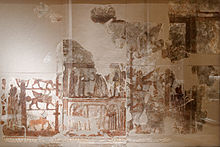User:Katmckmartin/sandbox
Frescoes[edit]
Figural frescoes were found in five rooms within the Palace of Mari. From those recovered, only four compositions were able to be restored[1], due to the deterioration of the materials and damage done by Hammurabi of Babylon's sacking of Mari circa 2760 BCE.[2]
The Investiture of Zimri-Lim[edit]

"The Investiture of Zimri-Lim," dating to the 18th century BCE and discovered during 1935–1936 excavations at Mari by French archaeologist André Parrot, was the only painting found in situ in the palace. The painting is distinguished in part by its wide range of color, including green and blue. Painted on a thin layer of mud plaster applied directly to the palace's brick wall, the scene features a warrior goddess, likely Ishtar, giving Zimri-Lim a ring and a staff, the symbols of kingship. The continuation of the red and blue painted border of the panel suggests that it was one of several adorning the walls of the room.[3]
Recent restoration efforts by the Louvre have revealed previously unseen details, such as scalloping on Zimri-Lim's robe, and unexpectedly vibrant colors, such as a brilliantly orange bull.[4]
Sacrifical procession scene[edit]
Fragments of a sacrificial procession scene were found at the base of the eastern half of the same wall on which "The Investiture of Zimri-Lim" was recovered. The painting has multiple registers and depicts a life-size figure leading men who are in turn leading a procession of sacrificial animals. The colors utilized are black, brown, red, white, and gray.[5]
The application technique of this scene differs from the thin mud plaster used as a base for other frescoes in the palace. The sacrificial procession scene utilized layered mud, which was scored to aid attachment to a top layer of thick gypsum plaster. The presence of both frescoes in the same room and the better preservation of the "Investiture" scene could mean that "Investiture" was an earlier painting, and that the concealing of this fresco by the later procession scene is what saved it from suffering the same degree of damage as the palace's other frescoes.[6]
"Audience chamber" frescoes[edit]
A number of wall-painting fragments were also discovered in from the south-western end of narrow room that Parrot dubbed the "king's audience chamber." These fragments were restored to a size of 2.8 meters (nearly ten feet) in height and 3.35 meters (nearly eleven feet) in width.[7]
The paintings include two major registers, each depicting a scene in which offerings are made to deities. The scenes are framed by mythological creatures and bordered top and bottom by striding men carrying bundles on their backs. The figures are outlined with thick black line, with red, gray, brown, yellow, and white pigments utilized throughout the painting.[8]
Other fragmentary images[edit]
Painting fragments found in the same room as the "Investiture of Zimri-Lim" and the sacrificial procession scene include goats in heraldic pose flanking a tree, a life-size figure with a dagger in his belt, a figure in front of an architectural background, and a hand grasping hair in a manner very similar to the traditional Egyptian scene of a king smiting an enemy with a mace.[9]
Others rooms yielded very fragmentary wall paintings, which may have fallen and broken partly as a result of the collapse of an upper story. The fragments fall into two general stylistic groups: figures resembling the bundle-bearing men in the "audience chamber" frescoes, and life-size figures bearing similarity to the sacrificial procession scene.[10]
- ^ Gates, Marie-Henriette . “The Palace of Zimri-Lim at Mari.” The Biblical Archaeologist, Vol. 47, No. 2 (Jun., 1984), pp. 70-87.
- ^ Louvre. “Mural Painting, Department of Near Eastern Antiquities: Mesopostamia.” Accessed November 28th, 2014. http://www.louvre.fr/en/oeuvre-notices/mural-painting
- ^ Gates, Marie-Henriette . “The Palace of Zimri-Lim at Mari.” The Biblical Archaeologist, Vol. 47, No. 2 (Jun., 1984), pp. 70-87.
- ^ Louvre. “Mural Painting, Department of Near Eastern Antiquities: Mesopostamia.” Accessed November 28th, 2014. http://www.louvre.fr/en/oeuvre-notices/mural-painting
- ^ Gates, Marie-Henriette . “The Palace of Zimri-Lim at Mari.” The Biblical Archaeologist, Vol. 47, No. 2 (Jun., 1984), pp. 70-87.
- ^ Gates, Marie-Henriette . “The Palace of Zimri-Lim at Mari.” The Biblical Archaeologist, Vol. 47, No. 2 (Jun., 1984), pp. 70-87.
- ^ Gates, Marie-Henriette . “The Palace of Zimri-Lim at Mari.” The Biblical Archaeologist, Vol. 47, No. 2 (Jun., 1984), pp. 70-87.
- ^ Gates, Marie-Henriette . “The Palace of Zimri-Lim at Mari.” The Biblical Archaeologist, Vol. 47, No. 2 (Jun., 1984), pp. 70-87.
- ^ Gates, Marie-Henriette . “The Palace of Zimri-Lim at Mari.” The Biblical Archaeologist, Vol. 47, No. 2 (Jun., 1984), pp. 70-87.
- ^ Gates, Marie-Henriette . “The Palace of Zimri-Lim at Mari.” The Biblical Archaeologist, Vol. 47, No. 2 (Jun., 1984), pp. 70-87.

